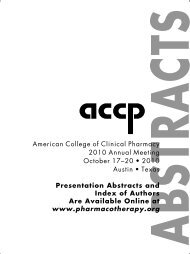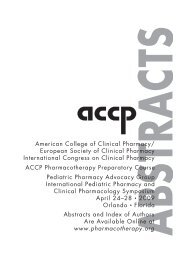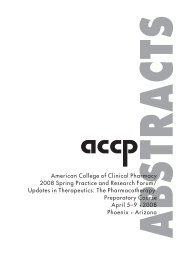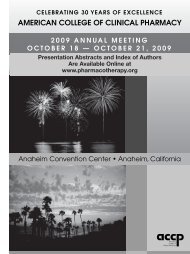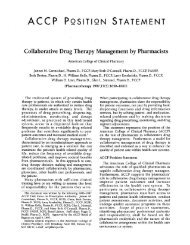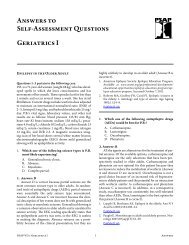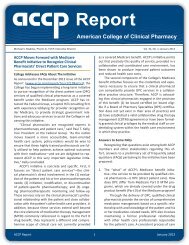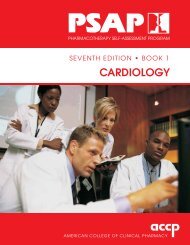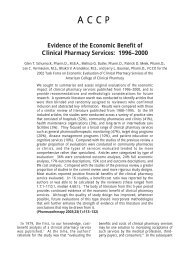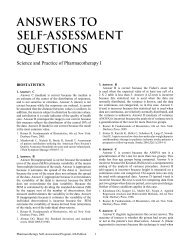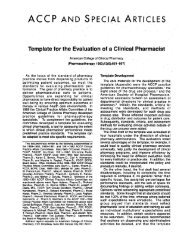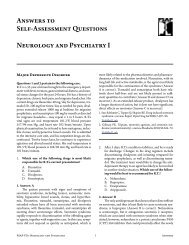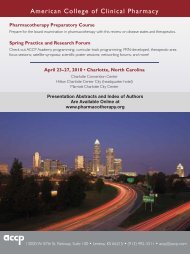Answers to Self-Assessment Questions - ACCP
Answers to Self-Assessment Questions - ACCP
Answers to Self-Assessment Questions - ACCP
You also want an ePaper? Increase the reach of your titles
YUMPU automatically turns print PDFs into web optimized ePapers that Google loves.
34. Answer: D<br />
T.O. is obese (i.e., 300% of IBW) and is continuing <strong>to</strong><br />
gain weight with her current PN formulation, which provides<br />
29 kcal/kg/day based on her actual weight and 58 kcal/kg/<br />
day based on an adjusted body weight for obesity. Thus,<br />
Answer A (continue the current PN formulation and follow<br />
up in 1 month) is not a good option for T.O. and is incorrect.<br />
Reducing the calories delivered by the PN formulation <strong>to</strong><br />
2500 kcal/day with 150 grams of protein per day (Answer<br />
C) is an appropriate intervention, but Answer D (decreasing<br />
the PN <strong>to</strong> 2500 kcal/day, maintaining 150 grams of protein<br />
per day, and attempting slow enteral feedings, is the best<br />
answer because T.O. should be given another trial of enteral<br />
feeding. Therefore, Answer C is incorrect and Answer D is<br />
the best answer. S<strong>to</strong>pping the PN and initiating either tube<br />
or oral feedings (Answer B) is not an appropriate option for<br />
T.O.; it will fail because she does not have adequate bowel<br />
length <strong>to</strong> have sufficient nutrient absorption <strong>to</strong> discontinue<br />
the PN.<br />
1. Siepler J. Principles and strategies for moni<strong>to</strong>ring home<br />
parenteral nutrition. Nutr Clin Prac 2007;22:340–50.<br />
2. ASPEN Board of Direc<strong>to</strong>rs and the Clinical Guidelines Task<br />
Force. Guidelines for the use of parenteral and enteral nutrition<br />
in adult and pediatric patients. JPEN 2002;26(1 Suppl):1SA–<br />
138SA.<br />
3. Seres DS. Surrogate nutrition markers, malnutrition, and<br />
adequacy of nutrition support. Nutr Clin Prac 2005;20:308–13.<br />
35. Answer: C<br />
T.O. has had an increase in s<strong>to</strong>ol output for the past<br />
2 days. The s<strong>to</strong>ol is foul-smelling, and she has crampy<br />
abdominal pain but is afebrile. She is concerned that the<br />
diarrhea will soon lead <strong>to</strong> dehydration without intervention.<br />
The best therapeutic intervention for T.O. is <strong>to</strong> start<br />
metronidazole 500 mg intravenously three times/day and<br />
order intravenous replacement fluids for her s<strong>to</strong>ol losses<br />
(Answer C), making Answer C the correct answer. Simply<br />
reassuring her that her PN formulation provides adequate<br />
volume for increased s<strong>to</strong>ol losses and having her call back in<br />
2–3 days (Answer A), is incorrect because her PN provides<br />
only 3 L/day, which will not be adequate if the s<strong>to</strong>ol volume<br />
has increased significantly. Answer B (start metronidazole<br />
500 mg intravenously three times/day and order intravenous<br />
replacement fluids) is not the best answer because with the<br />
severity of her SBS and the increased s<strong>to</strong>ol output, the transit<br />
time for metronidazole taken orally will likely be <strong>to</strong>o fast <strong>to</strong><br />
allow for efficacy. Admitting T.O. <strong>to</strong> the hospital for broadspectrum<br />
intravenous antibiotics (Answer D) is incorrect<br />
because T.O.’s symp<strong>to</strong>ms suggest bacterial overgrowth,<br />
which can be treated with metronidazole alone. Unless<br />
dehydration develops, bacterial overgrowth can usually be<br />
managed without hospital admission.<br />
1. Di Stefano M, Miceli E, Missanelli A, Corazza GR. Treatment<br />
of small intestine bacterial overgrowth. Eur Rev Med<br />
Pharmacol Sci 2005;9:217–22.<br />
2. Van Citters GW, Lin HC. Management of small intestinal<br />
bacterial overgrowth. Curr Gastroenterol Rep 2005;7:317–20.<br />
3. Parrish CR, Krenitsky J, Willcutts K, Radigan AE.<br />
Gastrointestinal disease. In: Gottschlick MM, DeLegge MH,<br />
Mat<strong>to</strong>x T, Mueller C, Worthing<strong>to</strong>n P, eds. The A.S.P.E.N.<br />
Nutrition Support Core Curriculum: A Case-based Approach<br />
– The Adult Patient. Silver Spring, MD: American Society for<br />
Parenteral and Enteral Nutrition, 2007, 508–39.<br />
36. Answer: B<br />
A 70-year-old woman is admitted <strong>to</strong> the hospital because<br />
of weight loss of unknown etiology. She has diabetes<br />
mellitus and gastroparesis (diagnosed 10 years ago) and is<br />
receiving nasojejunal feedings with a polymeric formula.<br />
After 2 weeks, she is gaining weight and her prealbumin<br />
concentration has increased. She is ready for discharge but<br />
is refusing <strong>to</strong> go home on tube feedings and would rather go<br />
home on PN. She has Medicare with no secondary provider.<br />
Because she is <strong>to</strong>lerating and responding <strong>to</strong> EN, Medicare<br />
will not cover the cost of PN therapy. Therefore, Answer<br />
A (place a tunneled CVAD, initiate PN, plan for discharge<br />
on home PN) and Answer C (discharge the patient <strong>to</strong> home<br />
on peripheral PN) are not good options for this patient who<br />
likely would not be able <strong>to</strong> pay for the cost of PN therapy.<br />
Additionally, peripheral PN is not a good option for use<br />
in the home because of the need <strong>to</strong> frequently replace the<br />
peripheral infusion site. Because she came in<strong>to</strong> the hospital<br />
with unexplained weight loss, sending her back home on<br />
a oral diet with intravenous hydration is not optimal. She<br />
likely will not continue <strong>to</strong> gain weight on this regimen, and<br />
the cost of intravenous hydration will not be reimbursed by<br />
Medicare. The best option for this patient is <strong>to</strong> discuss the<br />
complications of long-term PN with her and the fact that<br />
Medicare will not cover the cost of PN therapy, and try <strong>to</strong><br />
convince her <strong>to</strong> go home with jejunos<strong>to</strong>my tube feedings<br />
(Answer B), making Answer B the correct answer.<br />
1. Messing B, Joly F. Guidelines for management of home<br />
parenteral support in adult chronic intestinal failure patients.<br />
Gastroenterology 2006:130:S43–S51.<br />
2. Howard L. Home parenteral nutrition: survival, cost, and<br />
quality of life. Gastroenterology 2006;130:S52–S59.<br />
37. Answer: D<br />
R.C.’s labora<strong>to</strong>ry reports indicate that he is dehydrated.<br />
Therefore, doing nothing (Answer A), is not an appropriate<br />
response. The best response <strong>to</strong> R.C.’s current situation is<br />
<strong>to</strong> continue the PN formulation and give lactated Ringer’s<br />
2 L followed by lactated Ringer’s replacement for his<br />
jejunos<strong>to</strong>my losses (Answer D). Increasing the PN volume<br />
<strong>to</strong> 4.5 L may help correct the existing dehydration, but it<br />
may not be adequate depending on the jejunos<strong>to</strong>my output;<br />
therefore Answer B is not the best option. Correcting the<br />
dehydration first, then replacing the losses proactively<br />
is the best approach <strong>to</strong> prevent dehydration in the future.<br />
Answer C (increase the sodium acetate in the current PN<br />
formulation <strong>to</strong>150 mEq/day) would help <strong>to</strong> acutely correct<br />
R.C.’s metabolic acidosis, but it would not correct the<br />
dehydration; thus Answer C is not the best response.<br />
1. Parrish CR, Krenitsky J, Willcutts K, Radigan AE.<br />
Gastrointestinal disease. In: Gottschlick MM, DeLegge MH,<br />
Mat<strong>to</strong>x T, Mueller C, Worthing<strong>to</strong>n P, eds. The A.S.P.E.N.<br />
Nutrition Support Core Curriculum: A Case-based Approach<br />
– The Adult Patient. Silver Spring, MD: American Society for<br />
Parenteral and Enteral Nutrition, 2007, 508–39.<br />
2. Buchman AL, Scolapio J, Fryer J. AGA technical review<br />
on short bowel syndrome and intestinal transplantation.<br />
Gastroenterology 2003;124:1111–34.<br />
Pharmacotherapy <strong>Self</strong>-<strong>Assessment</strong> Program, 6th Edition 43 Gastroenterology and Nutrition <strong>Answers</strong>



